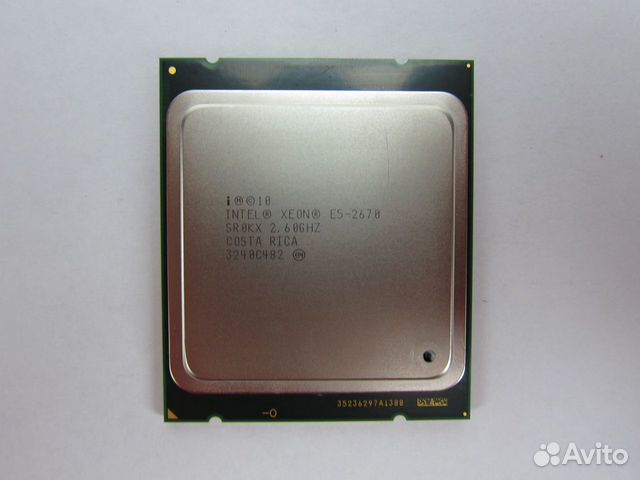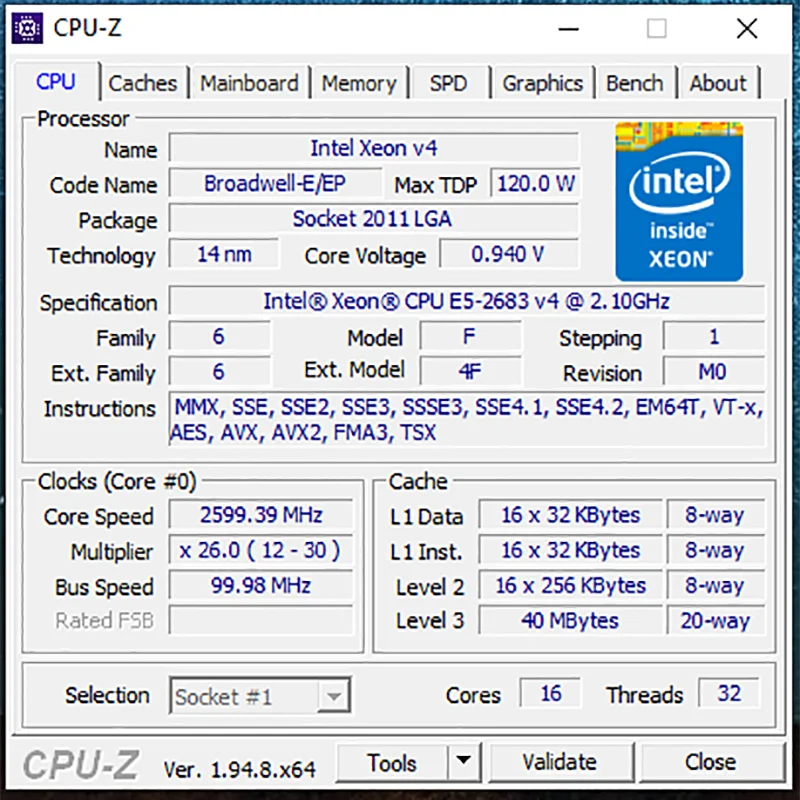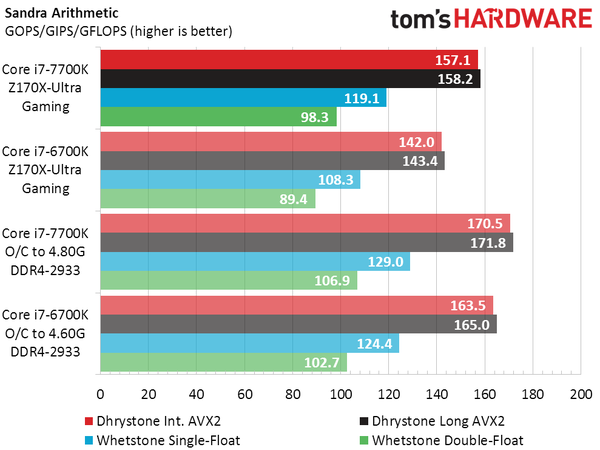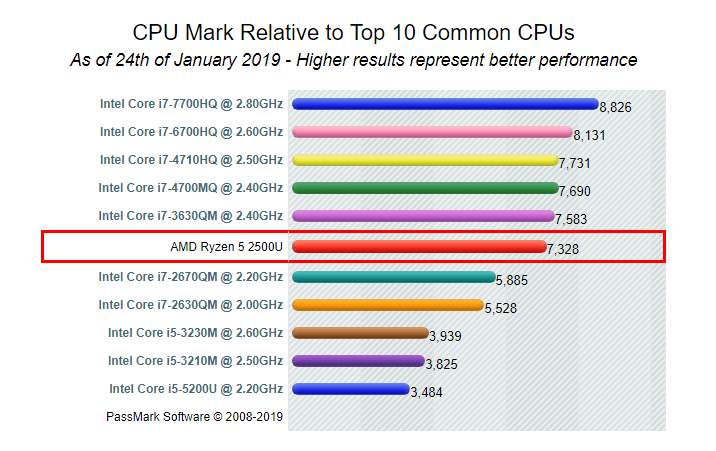Intel Core i7-6700 vs Intel Xeon E5-2670 Benchmarks, Specs, Performance Comparison and Differences
|
|
|
|
|
Intel Core i7-6700 vs Intel Xeon E5-2670
Comparison of the technical characteristics between the processors, with the Intel Core i7-6700 on one side and the Intel Xeon E5-2670 on the other side. The first is dedicated to the desktop sector, It has 4 cores, 8 threads, a maximum frequency of 4,0GHz. The second is used on the server segment, it has a total of 8 cores, 16 threads, its turbo frequency is set to 3,3 GHz. The following table also compares the lithography, the number of transistors (if indicated), the amount of cache memory, the maximum RAM memory capacity, the type of memory accepted, the release date, the maximum number of PCIe lanes, the values obtained in Geekbench 4 and Cinebench R15.
Note: Commissions may be earned from the links above.
This page contains references to products from one or more of our advertisers. We may receive compensation when you click on links to those products. For an explanation of our advertising policy, please visit this page.
Specification comparison:
| Processor | Intel Core i7-6700 | Intel Xeon E5-2670 | ||||||
| Market (main) | Desktop | Server | ||||||
| ISA | x86-64 (64 bit) | x86-64 (64 bit) | ||||||
| Microarchitecture | Skylake | Sandy Bridge | ||||||
| Core name | Skylake-S | Sandy Bridge-EP | ||||||
| Family | Core i7-6000 | Xeon E5-2600 | ||||||
| Part number(s), S-Spec |
BX80662I76700, |
BX80621E52670, |
||||||
| Release date | Q3 2015 | Q1 2012 | ||||||
| Lithography | 14 nm | 32 nm | ||||||
| Transistors | 1. 350.000.000 350.000.000 |
2.270.000.000 | ||||||
| Cores | 4 | 8 | ||||||
| Threads | 8 | 16 | ||||||
| Base frequency | 3,4 GHz | 2,6 GHz | ||||||
| Turbo frequency | 4,0 GHz | 3,3 GHz | ||||||
| Bus speed | 8 GT/s | 8 GT/s | ||||||
| Cache memory | 8 MB | 20 MB | ||||||
| Max memory capacity | 64 GB | 384 GB | ||||||
| Memory types |
DDR4-1866/2133, |
DDR3 800/1066/1333/1600 |
||||||
| Max # of memory channels | 2 | 4 | ||||||
| Max memory bandwidth | 34,1 GB/s | 51,2 GB/s | ||||||
| Max PCIe lanes | 16 | 40 | ||||||
| TDP | 65 W | 115 W | ||||||
| Suggested PSU | 600W ATX Power Supply | 650W ATX Power Supply | ||||||
| GPU integrated graphics | Intel HD Graphics 530 | None | ||||||
| GPU execution units | 24 | — | ||||||
| GPU shading units | 192 | — | ||||||
| GPU base clock | 350 MHz | — | ||||||
| GPU boost clock | 1150 MHz | — | ||||||
| GPU FP32 floating point | 403,2 GFLOPS | — | ||||||
| Socket | LGA1151 | LGA2011 | ||||||
| Compatible motherboard | Socket LGA 1151 Motherboard | Socket LGA 2011 Motherboard | ||||||
| Maximum temperature | 71°C | 81. 8°C 8°C |
||||||
| CPU-Z single thread | 428 | 318 | ||||||
| CPU-Z multi thread | 2.202 | 2.959 | ||||||
| Cinebench R15 single thread | 149 | 119 | ||||||
| Cinebench R15 multi-thread | 767 | 1.024 | ||||||
| Cinebench R23 single thread | 1.050 | 460 | ||||||
| Cinebench R23 multi-thread | 4.328 | 5.476 | ||||||
| PassMark single thread | 2.201 | 1.452 | ||||||
| PassMark CPU Mark | 8.042 | 8. 921 921 |
||||||
| (Linux 64-bit) Geekbench 4 single core |
4.565 | 2.649 | ||||||
| (Linux 64-bit) Geekbench 4 multi-core |
12.626 | 13.373 | ||||||
| (SGEMM) GFLOPS performance |
235,8 GFLOPS | 251,7 GFLOPS | ||||||
| (Multi-core / watt performance) Performance / watt ratio |
194 pts / W | 116 pts / W | ||||||
| Amazon | ||||||||
| eBay |
Note: Commissions may be earned from the links above.
We can better compare what are the technical differences between the two processors.
Suggested PSU: We assume that we have An ATX computer case, a high end graphics card, 16GB RAM, a 512GB SSD, a 1TB HDD hard drive, a Blu-Ray drive. We will have to rely on a more powerful power supply if we want to have several graphics cards, several monitors, more memory, etc.
Price: For technical reasons, we cannot currently display a price less than 24 hours, or a real-time price. This is why we prefer for the moment not to show a price. You should refer to the respective online stores for the latest price, as well as availability.
The processor Intel Xeon E5-2670 has a larger number of cores, the maximum frequency of Intel Core i7-6700 is greater, that the PDT of Intel Core i7-6700 is lower. The Intel Core i7-6700 was designed earlier.
Performance comparison with the benchmarks:
Performance comparison between the two processors, for this we consider the results generated on benchmark software such as Geekbench 4.
| CPU-Z — Multi-thread & single thread score | |
|---|---|
| Intel Xeon E5-2670 |
318 2.  959 959 |
| Intel Core i7-6700 |
428 2.202 |
In single core, the difference is 35%. In multi-core, the difference in terms of gap is 34%.
Note: Commissions may be earned from the links above. These scores are only an
average of the performances got with these processors, you may get different results.
CPU-Z is a system information software that provides the name of the processor, its model number, the codename, the cache levels, the package, the process. It can also gives data about the mainboard, the memory. It makes real time measurement, with finally a benchmark for the single thread, as well as for the multi thread.
| Cinebench R15 — Multi-thread & single thread score | |
|---|---|
| Intel Xeon E5-2670 |
119 1.024 |
| Intel Core i7-6700 |
149 767 |
In single core, the difference is 25%. In multi-core, the difference in terms of gap is 34%.
In multi-core, the difference in terms of gap is 34%.
Note: Commissions may be earned from the links above. These scores are only an
average of the performances got with these processors, you may get different results.
Cinebench R15 evaluates the performance of CPU calculations by restoring a photorealistic 3D scene. The scene has 2,000 objects, 300,000 polygons, uses sharp and fuzzy reflections, bright areas, shadows, procedural shaders, antialiasing, and so on. The faster the rendering of the scene is created, the more powerful the PC is, with a high number of points.
| Cinebench R23 — Multi-thread & single thread score | |
|---|---|
| Intel Xeon E5-2670 |
460 5.476 |
| Intel Core i7-6700 |
1.050 4.328 |
In single core, the difference is 128%. In multi-core, the difference in terms of gap is 27%.
In multi-core, the difference in terms of gap is 27%.
Note: Commissions may be earned from the links above. These scores are only an
average of the performances got with these processors, you may get different results.
Cinebench R23 is cross-platform testing software that allows you to assess the hardware capabilities of a device such as a computer, tablet, server. This version of Cinebench takes into account recent developments in processors with multiple cores and the latest improvements in rendering techniques. The evaluation is ultimately even more relevant. The test scene contains no less than 2,000 objects and more than 300,000 polygons in total.
| PassMark — CPU Mark & single thread | |
|---|---|
| Intel Xeon E5-2670 |
1.452 8.921 |
| Intel Core i7-6700 |
2.201 8.  042 042 |
In single core, the difference is 52%. In multi-core, the difference in terms of gap is 11%.
Note: Commissions may be earned from the links above. These scores are only an
average of the performances got with these processors, you may get different results.
PassMark is a benchmarking software that performs several performance tests including prime numbers, integers, floating point, compression, physics, extended instructions, encoding, sorting. The higher the score is, the higher is the device capacity.
On Windows 64-bit:
| Geekbench 4 — Multi-core & single core score — Windows 64-bit | |
|---|---|
| Intel Xeon E5-2670 |
2.554 19.286 |
| Intel Core i7-6700 |
4.434 14.685 |
In single core, the difference is 74%. In multi-core, the difference in terms of gap is 31%.
In multi-core, the difference in terms of gap is 31%.
On Linux 64-bit:
| Geekbench 4 — Multi-core & single core score — Linux 64-bit | |
|---|---|
| Intel Xeon E5-2670 |
2.649 13.373 |
| Intel Core i7-6700 |
4.565 12.626 |
In single core, the difference is 72%. In multi-core, the difference in terms of gap is 6%.
On Android 64-bit:
| Geekbench 4 — Multi-core & single core score — Android 64-bit | |
|---|---|
| Intel Xeon E5-2670 |
2.277 11.629 |
| Intel Core i7-6700 |
2.698 8.030 |
In single core, the difference is 18%. In multi-core, the difference in terms of gap is 45%.
On Mac OS X 64-bit:
| Geekbench 4 — Multi-core & single core score — Mac OS X 64-bit | |
|---|---|
| Intel Xeon E5-2670 |
3.033 19.664 |
| Intel Core i7-6700 |
4.866 16.460 |
In single core, the difference is 60%. In multi-core, the difference in terms of gap is 19%.
Note: Commissions may be earned from the links above. These scores are only an
average of the performances got with these processors, you may get different results.
Geekbench 4 is a complete benchmark platform with several types of tests, including data compression, images, AES encryption, SQL encoding, HTML, PDF file rendering, matrix computation, Fast Fourier Transform, 3D object simulation, photo editing, memory testing. This allows us to better visualize the respective power of these devices. For each result, we took an average of 250 values on the famous benchmark software.
For each result, we took an average of 250 values on the famous benchmark software.
Equivalence:
Intel Core i7-6700 AMD equivalentIntel Xeon E5-2670 AMD equivalent
See also:
Intel Core i7-6700HQIntel Core i7-6700KIntel Core i7-6700T
Dual Intel Xeon E5-2670Dual Intel Xeon E5-2670 v2Dual Intel Xeon E5-2670 v3Dual Intel Xeon E5-2673 v2Dual Intel Xeon E5-2673 v3Dual Intel Xeon E5-2673 v4Dual Intel Xeon E5-2676 v3Dual Intel Xeon E5-2678 v3Intel Xeon E5-2670 v2Intel Xeon E5-2670 v3Intel Xeon E5-2673 v2Intel Xeon E5-2673 v3Intel Xeon E5-2673 v4Intel Xeon E5-2676 v3Intel Xeon E5-2678 v3
Dual Intel Xeon E5-2670 vs Intel Core i7-6700 Benchmarks, Specs, Performance Comparison and Differences
|
|
|
|
|
Dual Intel Xeon E5-2670 vs Intel Core i7-6700
Comparison of the technical characteristics between the processors, with the Dual Intel Xeon E5-2670 on one side and the Intel Core i7-6700 on the other side. The first is dedicated to the server sector, It has 8 cores, 16 threads, a maximum frequency of 3,3GHz. The second is used on the desktop segment, it has a total of 4 cores, 8 threads, its turbo frequency is set to 4,0 GHz. The following table also compares the lithography, the number of transistors (if indicated), the amount of cache memory, the maximum RAM memory capacity, the type of memory accepted, the release date, the maximum number of PCIe lanes, the values obtained in Geekbench 4 and Cinebench R15.
The first is dedicated to the server sector, It has 8 cores, 16 threads, a maximum frequency of 3,3GHz. The second is used on the desktop segment, it has a total of 4 cores, 8 threads, its turbo frequency is set to 4,0 GHz. The following table also compares the lithography, the number of transistors (if indicated), the amount of cache memory, the maximum RAM memory capacity, the type of memory accepted, the release date, the maximum number of PCIe lanes, the values obtained in Geekbench 4 and Cinebench R15.
Note: Commissions may be earned from the links above.
This page contains references to products from one or more of our advertisers. We may receive compensation when you click on links to those products. For an explanation of our advertising policy, please visit this page.
Specification comparison:
| Processor | Dual Intel Xeon E5-2670 | Intel Core i7-6700 | ||||||
| Market (main) | Server | Desktop | ||||||
| ISA | x86-64 (64 bit) | x86-64 (64 bit) | ||||||
| Microarchitecture | Sandy Bridge | Skylake | ||||||
| Core name | Sandy Bridge-EP | Skylake-S | ||||||
| Family | Xeon E5-2600 | Core i7-6000 | ||||||
| Part number(s), S-Spec |
BX80621E52670, |
BX80662I76700, |
||||||
| Release date | Q1 2012 | Q3 2015 | ||||||
| Lithography | 32 nm | 14 nm | ||||||
| Transistors | 4. 540.000.000 540.000.000 |
1.350.000.000 | ||||||
| Cores | 16 | 4 | ||||||
| Threads | 32 | 8 | ||||||
| Base frequency | 2,6 GHz | 3,4 GHz | ||||||
| Turbo frequency | 3,3 GHz | 4,0 GHz | ||||||
| Bus speed | 16 GT/s | 8 GT/s | ||||||
| Cache memory | 40 MB | 8 MB | ||||||
| Max memory capacity | 768 GB | 64 GB | ||||||
| Memory types |
DDR3 800/1066/1333/1600 |
DDR4-1866/2133, |
||||||
| Max # of memory channels | 8 | 2 | ||||||
| Max memory bandwidth | 102,4 GB/s | 34,1 GB/s | ||||||
| Max PCIe lanes | 80 | 16 | ||||||
| TDP | 230 W | 65 W | ||||||
| Suggested PSU | 750W ATX Power Supply | 600W ATX Power Supply | ||||||
| GPU integrated graphics | None | Intel HD Graphics 530 | ||||||
| GPU execution units | — | 24 | ||||||
| GPU shading units | — | 192 | ||||||
| GPU base clock | — | 350 MHz | ||||||
| GPU boost clock | — | 1150 MHz | ||||||
| GPU FP32 floating point | — | 403,2 GFLOPS | ||||||
| Socket | LGA2011 | LGA1151 | ||||||
| Compatible motherboard | Socket LGA 2011 Motherboard | Socket LGA 1151 Motherboard | ||||||
| Maximum temperature | 81. 8°C 8°C |
71°C | ||||||
| CPU-Z single thread | 299 | 428 | ||||||
| CPU-Z multi thread | 5.801 | 2.202 | ||||||
| Cinebench R15 single thread | 119 | 149 | ||||||
| Cinebench R15 multi-thread | 2.002 | 767 | ||||||
| PassMark single thread | 1.495 | 2.201 | ||||||
| PassMark CPU Mark | 15.717 | 8.042 | ||||||
| (Linux 64-bit) Geekbench 4 single core |
2.322 | 4.565 | ||||||
| (Linux 64-bit) Geekbench 4 multi-core |
13. 677 677 |
12.626 | ||||||
| (SGEMM) GFLOPS performance |
185,7 GFLOPS | 235,8 GFLOPS | ||||||
| (Multi-core / watt performance) Performance / watt ratio |
59 pts / W | 194 pts / W | ||||||
| Amazon | ||||||||
| eBay |
Note: Commissions may be earned from the links above.
We can better compare what are the technical differences between the two processors.
Suggested PSU: We assume that we have An ATX computer case, a high end graphics card, 16GB RAM, a 512GB SSD, a 1TB HDD hard drive, a Blu-Ray drive. We will have to rely on a more powerful power supply if we want to have several graphics cards, several monitors, more memory, etc.
Price: For technical reasons, we cannot currently display a price less than 24 hours, or a real-time price. This is why we prefer for the moment not to show a price. You should refer to the respective online stores for the latest price, as well as availability.
The processor Dual Intel Xeon E5-2670 has more cores, the turbo frequency of Intel Core i7-6700 is bigger, that the thermal dissipation power of Intel Core i7-6700 is less. The Intel Core i7-6700 was started more recently.
Performance comparison with the benchmarks:
Performance comparison between the two processors, for this we consider the results generated on benchmark software such as Geekbench 4.
| CPU-Z — Multi-thread & single thread score | |
|---|---|
| Dual Intel Xeon E5-2670 |
299 5.801 |
| Intel Core i7-6700 |
428 2.  202 202 |
In single core, the difference is -30%. In multi-core, the differential gap is 163%.
Note: Commissions may be earned from the links above. These scores are only an
average of the performances got with these processors, you may get different results.
CPU-Z is a system information software that provides the name of the processor, its model number, the codename, the cache levels, the package, the process. It can also gives data about the mainboard, the memory. It makes real time measurement, with finally a benchmark for the single thread, as well as for the multi thread.
| Cinebench R15 — Multi-thread & single thread score | |
|---|---|
| Dual Intel Xeon E5-2670 |
119 2.002 |
| Intel Core i7-6700 |
149 767 |
In single core, the difference is -20%. In multi-core, the differential gap is 161%.
In multi-core, the differential gap is 161%.
Note: Commissions may be earned from the links above. These scores are only an
average of the performances got with these processors, you may get different results.
Cinebench R15 evaluates the performance of CPU calculations by restoring a photorealistic 3D scene. The scene has 2,000 objects, 300,000 polygons, uses sharp and fuzzy reflections, bright areas, shadows, procedural shaders, antialiasing, and so on. The faster the rendering of the scene is created, the more powerful the PC is, with a high number of points.
| PassMark — CPU Mark & single thread | |
|---|---|
| Dual Intel Xeon E5-2670 |
1.495 15.717 |
| Intel Core i7-6700 |
2.201 8.042 |
In single core, the difference is -32%. In multi-core, the differential gap is 95%.
In multi-core, the differential gap is 95%.
Note: Commissions may be earned from the links above. These scores are only an
average of the performances got with these processors, you may get different results.
PassMark is a benchmarking software that performs several performance tests including prime numbers, integers, floating point, compression, physics, extended instructions, encoding, sorting. The higher the score is, the higher is the device capacity.
On Windows 64-bit:
| Geekbench 4 — Multi-core & single core score — Windows 64-bit | |
|---|---|
| Dual Intel Xeon E5-2670 |
2.481 24.913 |
| Intel Core i7-6700 |
4.434 14.685 |
In single core, the difference is -44%. In multi-core, the differential gap is 70%.
On Linux 64-bit:
| Geekbench 4 — Multi-core & single core score — Linux 64-bit | |
|---|---|
| Dual Intel Xeon E5-2670 |
2.322 13.677 |
| Intel Core i7-6700 |
4.565 12.626 |
In single core, the difference is -49%. In multi-core, the differential gap is 8%.
On Android 64-bit:
| Geekbench 4 — Multi-core & single core score — Android 64-bit | |
|---|---|
| Dual Intel Xeon E5-2670 |
2.277 11.629 |
| Intel Core i7-6700 |
2.698 8.030 |
In single core, the difference is -16%. In multi-core, the differential gap is 45%.
On Mac OS X 64-bit:
| Geekbench 4 — Multi-core & single core score — Mac OS X 64-bit | |
|---|---|
| Dual Intel Xeon E5-2670 |
2. 
|
